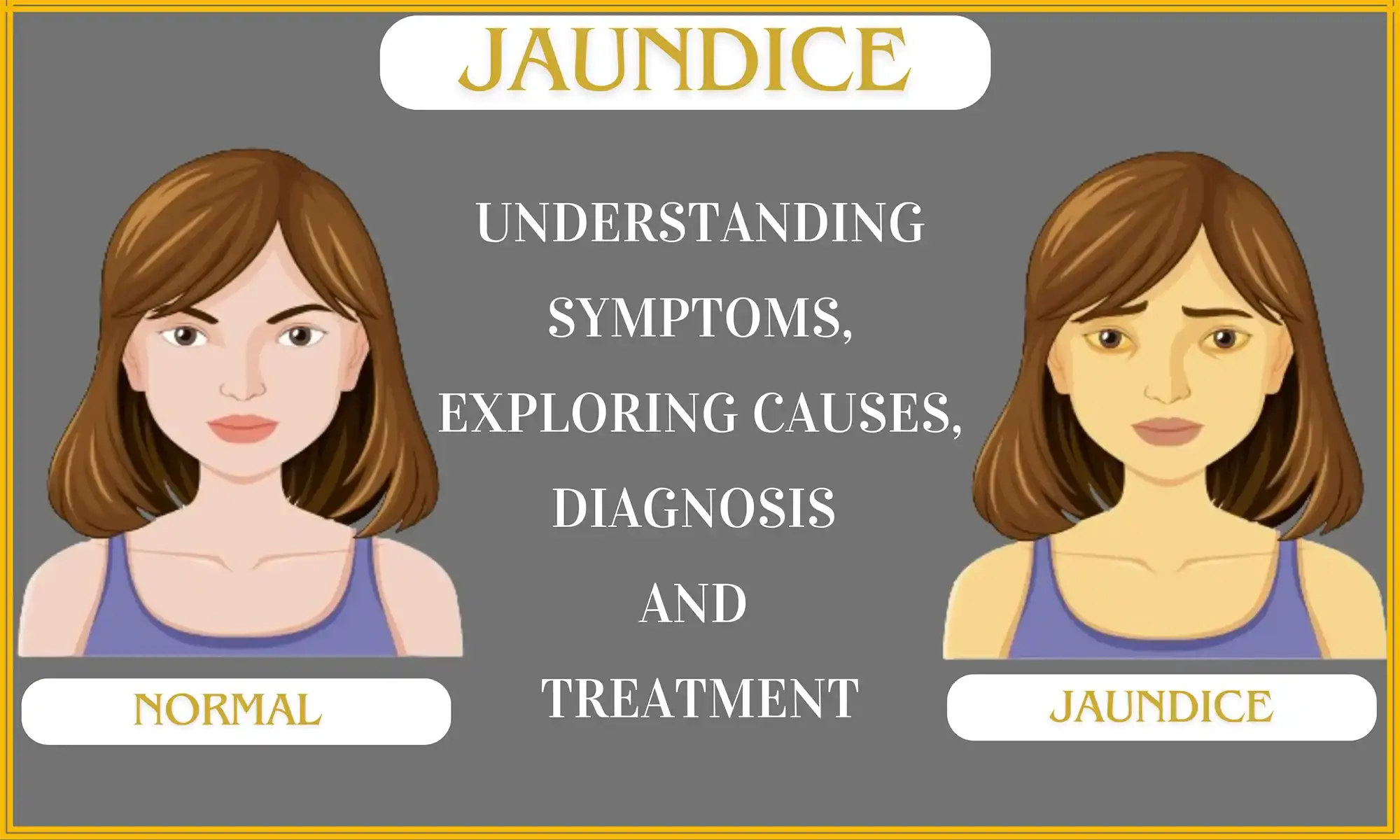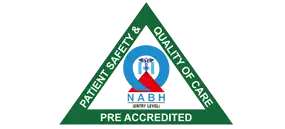
JAUNDICE UNDERSTANDING SYMPTOMS EXPLORING CAUSES DIAGNOSIS AND TREATMENT
Jaundice: Understanding Symptoms, Exploring Causes, Diagnosis and Treatment

What is Jaundice?
Jaundice, also known as icterus, is a medical condition characterized by the yellowing of the skin, mucous membranes, and whites of the eyes. It occurs when there is an excess of bilirubin in the blood, a yellow pigment produced during the normal breakdown of red blood cells. Jaundice can be a symptom of various underlying medical conditions affecting the liver, gallbladder, or bile ducts, such as hepatitis, cirrhosis, or gallstones. It can also occur as a result of hemolytic disorders, where red blood cells are destroyed more rapidly than usual. Jaundice may present with other symptoms such as dark urine, pale stools, fatigue, abdominal pain, or itching. Treatment depends on the underlying cause and may involve addressing liver dysfunction, managing symptoms, and addressing any complications. If you suspect you have jaundice, it's essential to seek medical evaluation for proper diagnosis and treatment.
Jaundice Disease Symptoms
Here the details of jaundice signs & symptoms:
- Yellowing of the Skin and Eyes (Jaundice):
The most prominent symptom of jaundice is the yellowing of the skin, mucous membranes (such as inside the mouth), and the whites of the eyes (sclera). This yellow discoloration occurs due to the buildup of bilirubin, a yellow pigment, in the blood and tissues.
- Dark Urine:
Jaundice may cause urine to appear dark or tea-colored. This darkening of urine is due to the presence of excess bilirubin, which is excreted by the kidneys and can give urine a darker hue.
- Pale Stools:
Stools may become pale or clay-colored in individuals with jaundice. Bilirubin normally gives stools their brown color, but when levels are elevated, the absence of bilirubin in the intestines can result in pale-colored stools.
- Yellowing of Other Tissues:
In addition to the skin, eyes, and mucous membranes, jaundice may also cause yellowing of other tissues such as the palms of the hands, soles of the feet, and nail beds.
- Itching (Pruritus):
Some individuals with jaundice may experience itching of the skin, known as pruritus. Itching is thought to be related to the deposition of bile salts in the skin, which can irritate nerve endings and lead to itching.
- Fatigue and Weakness:
Jaundice can be associated with feelings of fatigue, weakness, and general malaise. Elevated bilirubin levels and liver dysfunction can contribute to feelings of tiredness and decreased energy levels.
- Abdominal Pain:
In certain cases, jaundice may be accompanied by abdominal pain or discomfort. This pain may be localized to the right upper quadrant of the abdomen and can be indicative of underlying liver or gallbladder issues.
- Nausea and Vomiting:
Some individuals with jaundice may experience nausea, vomiting, or loss of appetite. These symptoms can occur due to the underlying cause of jaundice, such as liver inflammation or obstruction of the bile ducts.
- Fever:
In cases of infectious hepatitis or other inflammatory conditions affecting the liver, jaundice may be accompanied by fever. Fever is the body's response to infection or inflammation and may be present in addition to other jaundice symptoms.
Causes of Jaundice Disease
Depending on the underlying cause of jaundice, individuals may experience other symptoms of liver dysfunction, such as swelling of the abdomen (ascites), confusion or altered mental status (encephalopathy), or bleeding tendencies due to impaired blood clotting function.
Jaundice can occur due to various underlying conditions that disrupt the normal process of bilirubin metabolism and elimination.
Here are some common causes of jaundice:
- Hepatitis:
Hepatitis, which is inflammation of the liver, can be caused by viral infections (hepatitis A, B, C, D, or E), autoimmune diseases, alcohol abuse, or certain medications and toxins. The liver's inflammation can hinder its capacity to metabolize bilirubin, resulting in the development of jaundice.
- Liver Cirrhosis:
Cirrhosis is a late stage of scarring (fibrosis) of the liver caused by long-term liver damage from conditions such as chronic hepatitis, alcohol abuse, or non-alcoholic fatty liver disease. As liver function declines due to cirrhosis, bilirubin metabolism may be impaired, resulting in jaundice.
- Obstruction of the Bile Ducts:
Obstruction of the bile ducts can occur due to gallstones, tumors, inflammation, or strictures (narrowing) of the bile ducts. When bile flow is blocked, bilirubin cannot be properly excreted into the intestines, leading to its accumulation in the blood and tissues, resulting in jaundice.
- Gilbert's Syndrome:
Gilbert's syndrome is a genetic condition characterized by mild elevation of bilirubin levels in the blood. People with Gilbert's syndrome have a decreased ability to process bilirubin, which can result in occasional episodes of jaundice, particularly during times of illness, stress, or fasting.
- Hemolytic Disorders:
Hemolytic disorders are conditions characterized by the premature destruction of red blood cells, leading to an increase in bilirubin production. Conditions such as hemolyticanemia, sickle cell disease, thalassemia, and glucose-6-phosphate dehydrogenase (G6PD) deficiency can result in excessive bilirubin production and subsequent jaundice.
- Alcoholic Liver Disease:
Chronic alcohol abuse can lead to alcoholic liver disease, which encompasses a spectrum of liver disorders including fatty liver, alcoholic hepatitis, and cirrhosis. Alcohol-related liver damage can impair bilirubin metabolism and elimination, contributing to jaundice.
- Drug-Induced Liver Injury:
Certain medications, herbal supplements, and toxins can cause liver damage and impair bilirubin processing, leading to jaundice. Examples of medications associated with drug-induced liver injury include acetaminophen (Tylenol), certain antibiotics, statins, and chemotherapy drugs.
- Inherited Metabolic Disorders:
Rare inherited metabolic disorders, such as Crigler-Najjar syndrome and Dubin-Johnson syndrome, can affect bilirubin metabolism and result in jaundice. These conditions are characterized by deficiencies or abnormalities in enzymes involved in bilirubin processing.
- Pancreatic Cancer:
Pancreatic cancer can obstruct the bile ducts as it grows, leading to bile accumulation and jaundice. Jaundice caused by pancreatic cancer is often accompanied by other symptoms such as abdominal pain, weight loss, and digestive problems.
Diagnosis of Jaundice
Diagnosing jaundice typically involves a combination of medical history, physical examination, laboratory tests, and imaging studies.
Here are common diagnostic methods used to evaluate jaundice:
- Medical History and Physical Examination:
The healthcare provider will begin by taking a detailed medical history, including symptoms, duration of jaundice, any recent illnesses, medications, alcohol consumption, and exposure to toxins or infectious agents. A thorough physical examination will be conducted to assess the extent of jaundice and any associated symptoms.
- Bilirubin Blood Tests:
Blood tests are performed to measure levels of bilirubin in the blood. Total bilirubin measures the total amount of bilirubin, including both indirect (unconjugated) and direct (conjugated) bilirubin. Elevated levels of total bilirubin indicate jaundice, and the ratio of direct to indirect bilirubin can help determine the underlying cause.
- Liver Function Tests (LFTs):
Liver function tests assess the levels of enzymes and proteins produced by the liver. Abnormalities in LFTs, such as elevated levels of liver enzymes (AST, ALT) and alkaline phosphatase (ALP), may indicate liver dysfunction or damage.
- Complete Blood Count (CBC):
A complete blood count is performed to evaluate red blood cell count, white blood cell count, and platelet count. Abnormalities in red blood cell indices (e.g., decreased hemoglobin) may suggest hemolyticanemia as a cause of jaundice.
- Coagulation Profile:
Coagulation studies, including prothrombin time (PT) and international normalized ratio (INR), assess blood clotting function. Abnormalities in coagulation profile may indicate impaired liver function.
- Serological Tests for Viral Hepatitis:
Serological tests, such as hepatitis A, B, and C antibodies and viral load tests, are performed to detect viral hepatitis infections, which are common causes of jaundice.
- Imaging Studies:
Imaging tests, such as ultrasound, computed tomography (CT) scan, or magnetic resonance imaging (MRI), may be ordered to evaluate the liver, gallbladder, and bile ducts for evidence of obstruction, inflammation, or structural abnormalities.
- Liver Biopsy:
In some cases, a liver biopsy may be performed to obtain a tissue sample for microscopic examination. A liver biopsy can help diagnose liver diseases such as cirrhosis, hepatitis, or liver cancer and assess the extent of liver damage.
- Other Tests:
Depending on the suspected underlying cause of jaundice, additional tests may be performed, such as autoimmune markers, alpha-fetoprotein (AFP) tumor marker, or genetic tests for inherited metabolic disorders.
Jaundice Disease Treatment
The treatment of jaundice depends on the underlying cause and severity of the condition.
Here are some common treatment approaches for jaundice:
- Treating the Underlying Cause:
Addressing the underlying cause of jaundice is essential for effective treatment. Depending on the diagnosis, treatment may involve medications, lifestyle modifications, or procedures to manage liver disease, bile duct obstruction, viral hepatitis, hemolytic disorders, or other contributing factors.
- Medications:
Medications may be prescribed to treat specific underlying conditions contributing to jaundice. For example, antiviral medications may be used to treat viral hepatitis, while corticosteroids or immunosuppressive drugs may be prescribed for autoimmune hepatitis. Medications to manage symptoms such as itching or nausea may also be prescribed as needed.
- Fluid and Electrolyte Management:
Intravenous fluids may be administered to maintain hydration and electrolyte balance, particularly in cases of severe jaundice associated with dehydration or electrolyte disturbances. Fluid therapy can help support liver function and prevent complications such as hepatic encephalopathy.
- Nutritional Support:
Nutritional support may be provided to individuals with jaundice, especially those with underlying liver disease or malnutrition. A balanced diet rich in protein, carbohydrates, vitamins, and minerals can support liver function and promote healing. In some cases, dietary modifications such as reducing fat intake may be recommended.
- Liver Supportive Therapies:
Liver supportive therapies, such as hepatoprotective agents or antioxidants, may be used to support liver function and protect against further damage. These may include medications containing substances like silymarin (milk thistle), N-acetylcysteine (NAC), or vitamin E.
- Phototherapy:
Phototherapy, also known as light therapy, may be used to treat jaundice in newborns (neonatal jaundice). Phototherapy involves exposing the baby's skin to special fluorescent lights that help break down bilirubin into a form that can be excreted by the body. This treatment is usually performed in the hospital or under medical supervision.
- Surgical Interventions:
In cases of obstructive jaundice due to bile duct obstruction or structural abnormalities, surgical interventions may be necessary to relieve the blockage. This may involve procedures such as endoscopic retrograde cholangiopancreatography (ERCP), biliary stent placement, or surgical removal of gallstones or tumors.
- Liver Transplantation:
In severe cases of liver failure or end-stage liver disease, liver transplantation may be considered as a treatment option. Liver transplantation involves surgically replacing a diseased liver with a healthy liver from a donor. It is reserved for individuals with irreversible liver damage who have failed other treatment options.
- Monitoring and Follow-Up:
Regular monitoring and follow-up are essential for individuals with jaundice to assess treatment response, monitor liver function, and prevent complications. Healthcare providers may perform repeat blood tests, imaging studies, or other diagnostic tests to evaluate progress and adjust treatment as needed.
Treatment of jaundice is individualized based on the underlying cause, severity of symptoms, and overall health of the patient. It's essential to work closely with a healthcare provider to develop a comprehensive treatment plan that addresses all aspects of the condition and promotes optimal recovery. Early diagnosis and appropriate management can help improve outcomes and prevent complications.
FAQ's
- 1.Can jaundice be cured?
Jaundice is frequently treatable. The treatment approach varies based on the root cause, typically involving addressing the issue that is affecting the liver's function. Rest, hydration, and medication can sometimes suffice to aid in the liver's recovery, but in more serious instances, medical interventions may be required.
- 2.What is the main reason for jaundice?
Jaundice is a common condition that arises when there is an excess of bilirubin in the bloodstream. Bilirubin, a yellow pigment formed from the breakdown of red blood cells, is responsible for this discoloration. When the liver fails to effectively process bilirubin, it builds up in the body, resulting in the distinct yellowing of the skin and eyes associated with jaundice. This liver dysfunction can be attributed to a range of factors, including liver disease, obstruction of the bile ducts, or specific infections.
- 3.How do you clear jaundice?
To effectively address jaundice, it is crucial to treat the root cause that hampers the liver's ability to process bilirubin. This may entail implementing measures such as rest, ensuring proper hydration, and administering medication to support liver function. In more severe instances, medical interventions such as surgery or other procedures might be required to eliminate blockages or directly address liver complications.
- 4.What not to eat in jaundice?
It is recommended to steer clear of fatty, greasy, and fried foods when dealing with jaundice, as they may pose a challenge for the liver to metabolize. Additionally, it is advisable to restrict the consumption of alcohol, spicy dishes, as well as foods rich in sugar or salt. Instead, prioritize the intake of easily digestible foods such as fruits, vegetables, lean proteins, and whole grains to promote liver well-being and facilitate the recovery process.
- 5.What are the symptoms of starting jaundice?
During the initial phases of jaundice, one may observe the occurrence of yellowing in the skin and eyes, which is the predominant symptom. Additional early indications may encompass fatigue, weakness, and abdominal discomfort. If these symptoms manifest, it is crucial to seek medical attention for accurate diagnosis and appropriate treatment.



